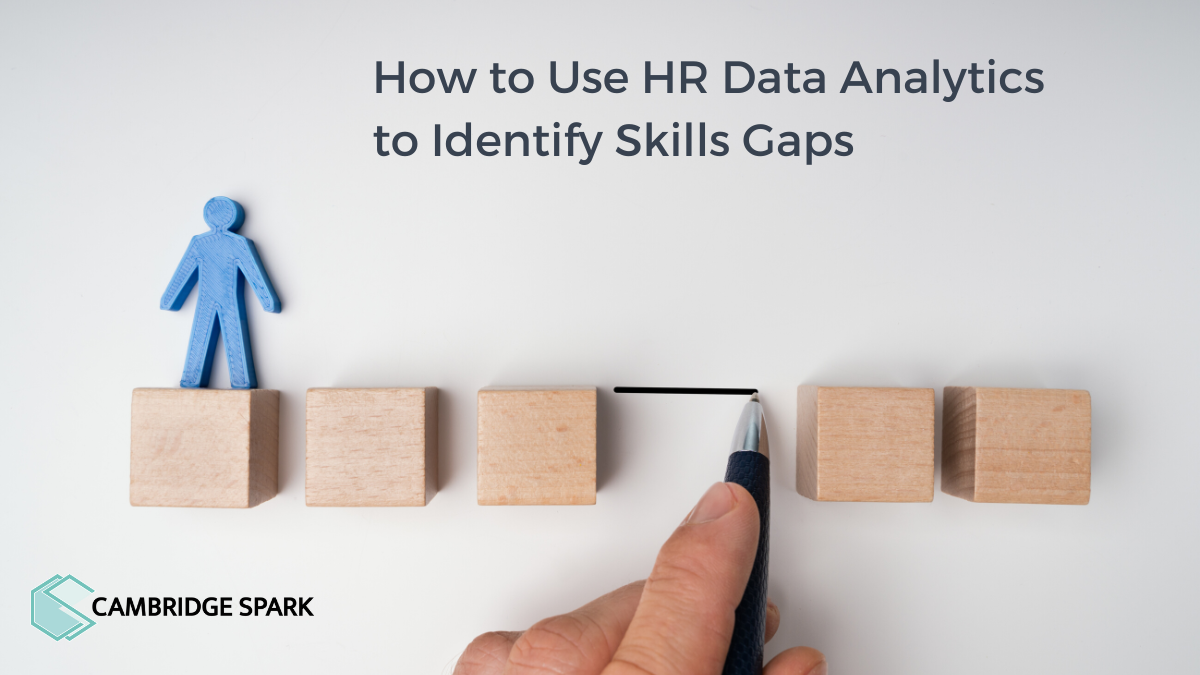A study from McKinsey & Company found that a whopping 87% of organisations are experiencing skills gaps within their workforce or expect to be in the near future.
What is a skills gap in the workplace?
So what do we mean when we talk about skills gaps? Skills gaps in a workplace refers to the mismatch between the skills and knowledge required for a particular job or industry and the skills possessed by the existing workforce.
These gaps can occur for several different reasons, such as technological advancements, changing market demands, and evolving job roles. When skills gaps exist, employers can find it challenging to fill positions with qualified individuals who possess the necessary competencies.
Unfortunately, skills gaps can hinder productivity, innovation, and overall organisational growth. Addressing skills gaps often involves implementing training programmes, upskilling or reskilling employees, and fostering a culture of continuous learning.
By bridging the gaps, organisations can enhance their workforce's capabilities, adapt to changing landscapes, and remain competitive in a dynamic and ever-evolving professional environment.
An example of a skills gap in industry
Let's consider a scenario where a company decides to adopt a new software system to streamline their operations and increase efficiency. However, upon implementation, they realise that a significant number of employees lack the necessary skills to effectively use the new software.
In this case, the skills gap lies in the employees' proficiency with the new software. They may not be familiar with its functionalities, features, or how to navigate the interface. As a result, they struggle to perform tasks efficiently and fully utilise the software's capabilities.
This struggle and the resulting drain on productivity could have been avoided with HR data analysis performed before implementing the new software.
What is HR data analytics?
We’ve all heard of data analysis, but what is analytics in HR, specifically? HR analytics is the collection and analysis of data and statistical methods to gain insights and make informed decisions about HR processes. Key data sources include employee records, performance evaluations, recruitment data, employee surveys, and training records.
The analysis of these data helps optimise talent management, improve engagement, and drive organisational success, leading to a more successful business overall.
The benefits of using HR data analytics to identify skill gaps:
Here are a few key benefits your organisation can enjoy when you use HR analytics to identify skills gaps in your workforce.
- Enhanced decision-making: HR analytics provides objective and data-driven insights, enabling informed decision-making when it comes to addressing skills gaps. Data can also be used as quantitative evidence to support new initiatives proposed to stakeholders and internal team members.
- Proactive skill planning: By identifying skills gaps in advance, organisations can proactively plan for future skill requirements. This allows them to develop targeted training programmes, hire talent with the necessary skills, or initiate upskilling/reskilling programmes to bridge the gaps.
- Cost optimisation: HR analytics helps organisations allocate training budgets efficiently by targeting specific areas of skill gaps. It minimises unnecessary spending on training programmes that may not directly address critical skill deficiencies.
- Improved productivity and performance: By addressing skills gaps, employees become more competent, productive, and capable of meeting job requirements. This can lead to increased overall performance and efficiency within the organisation.
- Talent retention and engagement: Identifying and addressing skills gaps demonstrates an organisation's commitment to employee growth and development. This can boost employee morale, engagement, and satisfaction, contributing to talent retention and reducing turnover.
- Competitive advantage: Closing skills gaps enables organisations to stay ahead of the curve and adapt to changing market demands. It helps them build a skilled workforce capable of meeting current and future challenges, giving them a competitive edge in their industry.
- Succession planning: HR analytics helps identify skills gaps in key positions, allowing organisations to proactively plan for succession. It ensures a smooth transition and continuity of critical roles, reducing the risk associated with talent gaps due to retirements or departures.
Key metrics to track for skill gap analysis
Several key metrics can give you valuable insights when measuring skills gaps in the workplace. Some of these metrics include:
- Job Vacancy Rate: This metric measures the percentage of open positions that remain unfilled for a specific period.
- Time-to-Fill: This measures the average time it takes to fill a job vacancy from the posting date to the offer acceptance. A longer time-to-fill can suggest challenges in finding candidates with the required skills.
- Employee Performance: Assessing employee performance against predefined performance indicators or goals can help identify areas where skills gaps exist. Employees consistently falling short of expectations may indicate a need for additional training or development.
- Training Participation and Completion Rates: Monitoring the rate at which employees participate in and successfully complete training programmes can provide insights into their willingness and ability to acquire necessary skills. Low participation or completion rates may signal a skills gap.
- Employee Surveys and Feedback: Gathering employee feedback through surveys, focus groups, or one-on-one discussions can provide qualitative insights into their perceived skills gaps. Their input can help identify specific areas where additional training or support is needed.
- Employee Turnover: High employee turnover rates, particularly among high-performing individuals, may indicate dissatisfaction or a skills gap that is not being addressed. Tracking turnover can help identify areas where skills gaps are impacting retention.
- Skills Assessments and Testing: Implementing skills assessments or proficiency tests can provide objective data on employees' current skills and knowledge levels. Comparing these results to the desired skill requirements can help identify specific gaps.
The importance of identifying skills gaps through analysis
Skill gap analysis is important in helping organisations keep their workforce on top of their game and stay ahead in today's fast-paced business world. It's about figuring out where employees are lacking the knowledge or expertise they need to do their jobs to a high standard. This analysis helps companies take charge and do something about those gaps. They can create tailored training programmes, give their employees extra skills through upskilling or reskilling, or even bring in new talent who already have the right skills.
When companies bridge those skill gaps, employee performance gets a boost, productivity rises, and there's a buzz of continuous learning and growth. Plus, it sets the stage for a culture where everyone is always developing professionally. Not only that, but skill gap analysis also helps organisations plan for the future. You can make sure you have the right talent to tackle new technologies, industry trends, and customer demands. By investing in finding and fixing skill gaps, your organisation can set itself up for long-term success and keep your competitive edge.
Tomas Chamorro-Premuzic, chief innovation officer at ManpowerGroup and professor of business psychology at Columbia University and UCL said that leaders should be “betting on potential future talent rather than ready-talent” and to also focus on “what they could learn and do, rather than desperately looking for those who have done it in the past”.

How to identify skill gaps through data analysis
Data analysis can be a real game-changer for organisations when it comes to defining the skills and competencies they need. Below we’ve broken down a few ways in which data analysis can help with this process.
- Job analysis: By diving into job descriptions, performance metrics, and employee feedback, data analysis can give organisations a clear picture of the tasks, responsibilities, and skills required for different roles. It's like taking a magnifying glass to understand what exactly each job entails.
- Skills gap analysis: This is where data analysis helps compare the skills employees currently have with the skills required for specific roles. By identifying any gaps between the two, organisations can pinpoint where additional training or recruitment efforts are needed.
- Performance data analysis: Data analysis can uncover the skills and competencies that contribute to high performance. By studying what makes a high performing employee, initiatives can be introduced to upskill other members of the team in these specific areas or skills.
- Industry benchmarking: Data analysis allows organisations to compare their skill requirements with industry benchmarks and best practices. This helps them stay up to date with the latest trends and adjust their skill requirements to remain competitive.
- Forecasting future skill requirements: Based on factors like technology advancements, market trends, and organisational goals, HR data analytics enables organisations to stay ahead of the game and define the skills and competencies that will be in demand.
- Employee feedback and surveys: By analysing this data, organisations can uncover recurring themes, concerns, and suggestions related to skills and competencies. This valuable input helps shape the skill definition process and ensures that employees' perspectives are taken into account.

Overcoming Challenges in Using HR Data Analytics for Skills Gap Analysis
Whilst using HR data analytics is an effective way to identify skills gaps in your organisation, there are also considerations to take into account. Handling of the data should follow the below guidelines to produce the most worthwhile results:
- Identifying Relevant Metrics and Indicators: Selecting the appropriate metrics and indicators to measure skill gaps accurately can be challenging. HR professionals need to define meaningful metrics that align with the organisation's strategic objectives and specific skill requirements.
- Aligning Data Analysis with Business Goals: Linking the insights from HR data analytics to business goals and objectives can be difficult. HR professionals must ensure that skill gap analysis outcomes are translated into actionable strategies and integrated into talent management and training programmes effectively.
- Maintaining Data Currency: HR data is dynamic and subject to change as employees join, leave, or develop new skills. Regularly updating and maintaining the data can be a challenge to ensure the accuracy and relevance of skill gap analysis.
- Ethical Considerations: Using HR data analytics raises ethical considerations related to employee privacy, bias, and fairness. HR professionals must handle data responsibly, ensuring that analyses and decisions are made in an ethical and unbiased manner.
How Google closed their skills gap with the help of data
Google recognised the need to address skills gaps within their organisation and empower employees to learn from each other. To accomplish this, they launched the "Googler to Googler" (g2g) programme, which aimed to leverage internal expertise to bridge skills gaps and foster a culture of continuous learning.
This volunteer training programme is made up of over 7000 employees across a wide range of departments. Employees can take part in various ways, from being mentors to designing training materials.
Google collected and analysed HR data to identify skills gaps and understand the areas where employees needed additional knowledge or expertise. Not only did they use data to understand their skills gaps, but also to use as evidence when explaining the importance of employee participation to managers.
Looking to leverage HR data analytics to bridge the skills gaps in your organisation?
At Cambridge Spark, we offer a tailored and publicly funded Data Citizen Apprenticeship with People Analytics Pathway which includes content from the Chartered Institute of Personnel and Development (CIPD).
The apprenticeship provides learners with the ability to contextualise what they have learnt in their Data Citizen Apprenticeship towards people functions. They can gain a better understanding of how data can be used to identify and address skills gaps within organisations.
If you’re interested in upskilling your organisation in people analytics, get in touch with us via the form below.
